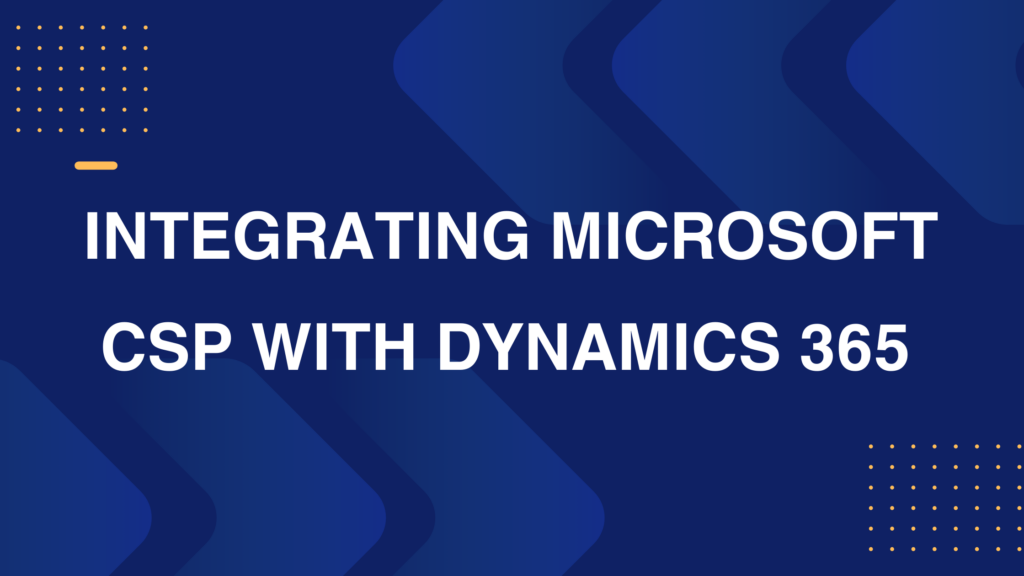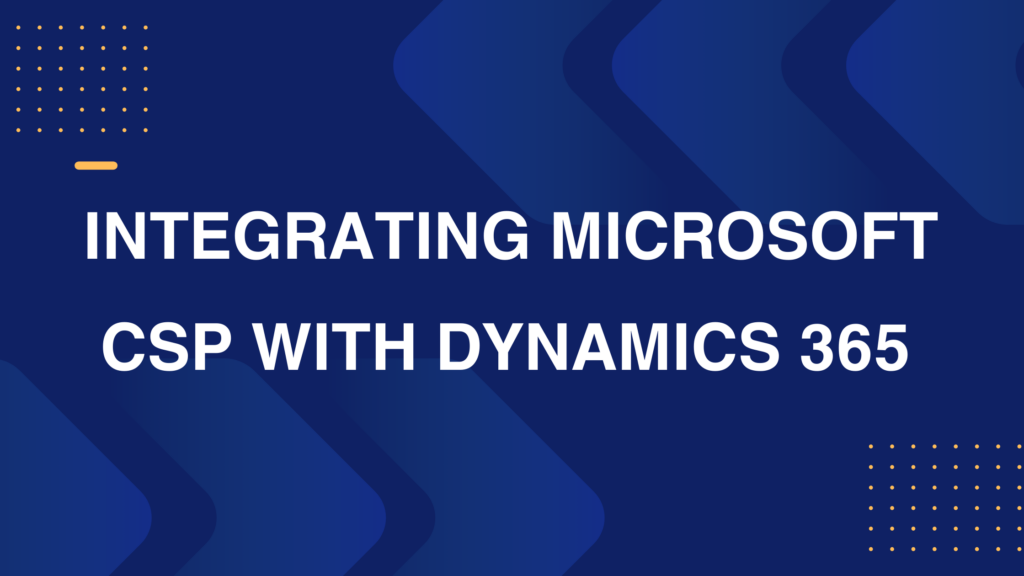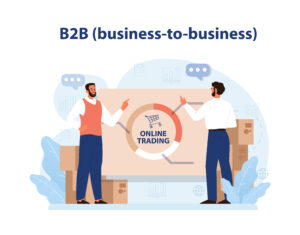
Microsoft Cloud Solution Providers (CSPs) are always looking for ways to make their operations more efficient and improve customer experiences. A pivotal strategy in achieving this is integrating Microsoft CSP with Dynamics 365. This integration simplifies CSP management, automates customer relationship management (CRM), enriches cloud marketplace offerings, and optimizes automated provisioning. In this article, we discuss the smooth integration of Microsoft CSP and Dynamics 365, providing insights on how to build a successful cloud marketplace and implement best practices for automated provisioning.
Seamless Integration Tips for CSP Management and Dynamics 365
Integrating Microsoft CSP with Dynamics 365 can significantly streamline operations and enhance efficiency. Here are key tips for a seamless integration:
Utilize Microsoft’s Partner Center API
The integration of Microsoft’s Partner Center API with Dynamics 365 represents a critical technological advancement for Cloud Solution Providers (CSPs). This integration facilitates a direct communication channel between Dynamics 365 and the CSP Partner Center, allowing for an unprecedented level of real-time data exchange and management. The implications for operational efficiency are profound:Real-Time Data Sync: Immediate data synchronization between Dynamics 365 and the Partner Center ensures that CSPs have up-to-the-minute insights into customer subscriptions, usage, and service health.
Automated Account Management: By leveraging the API, CSPs can automate routine tasks such as user creation, license allocation, and service provisioning, dramatically reducing manual effort and the potential for error.
Enhanced Customer Insight: Access to real-time data enables CSPs to understand customer behaviors and preferences better, facilitating more personalized and timely service offerings.
Automate Customer Onboarding
Automating the customer onboarding process through Dynamics 365 streamlines operations and significantly enhances the customer experience. By leveraging Dynamics 365, CSPs can:Streamline Account Setup: Automate the creation of new customer accounts, including the setup of user credentials and access permissions, ensuring a seamless start for customers.
Personalized Onboarding Journeys: Use the data within Dynamics 365 to tailor the onboarding process to the specific needs and preferences of each customer, from personalized email communications to custom setup checklists.
Immediate Access to Services: Through automation, customers can gain instant access to purchased services, reducing wait times and improving satisfaction from the outset.
Synchronize Billing and Subscription Data
The synchronization of billing and subscription data between Dynamics 365 and the CSP Partner Center is pivotal for providing a cohesive customer experience. This synchronization ensures:Unified Customer View: CSPs can obtain a 360-degree view of each customer, including their subscription details, billing history, and service usage, all within Dynamics 365. This unified view is crucial for delivering personalized customer service and targeted marketing campaigns.
Accurate Billing Information: By automatically updating billing and subscription data in Dynamics 365, CSPs ensure accuracy in invoicing and reduce the potential for billing discrepancies, enhancing customer trust.
Proactive Account Management: With up-to-date subscription and billing information, CSPs can proactively manage customer accounts, identifying upsell and cross-sell opportunities as well as addressing any potential issues before they escalate.
Microsoft CSP with Dynamics 365: Automating Customer Relationship Management
Dynamics 365 plays a crucial role in automating CRM processes for CSPs. Here’s how:
Centralized Customer Insights
Utilizing Dynamics 365 enables Cloud Solution Providers (CSPs) to amalgamate and analyze customer data collected from various interaction points, such as service usage, feedback channels, and direct communications. This holistic view of customer data is vital in creating personalized services and products that align with customer preferences and behaviors. The ability to anticipate customer needs based on past interactions and trends not only enhances the customer experience but also positions CSPs as proactive and attentive partners in their customers’ journey. By leveraging these insights, CSPs can refine their offerings, ensuring they remain relevant and valuable to their customers.
Automated Sales and Marketing Processes
Dynamics 365’s automation capabilities transform sales and marketing efforts by streamlining workflows and eliminating manual tasks. This automation empowers CSPs to manage their sales pipelines efficiently, from lead generation to closing deals, ensuring that no opportunity is missed. In marketing, Dynamics 365 enables the creation and deployment of targeted campaigns that reach the right audience at the optimal time, thereby increasing the effectiveness of marketing efforts. Automation ensures consistency in customer communications and engagements, fostering a seamless and personalized customer journey that enhances conversion rates and customer retention.
Enhanced Customer Service
The implementation of service automation through Dynamics 365 revolutionizes how CSPs address customer issues and inquiries. Automated ticketing systems, AI-driven chatbots, and self-service portals empower customers to find solutions quickly, while also freeing up customer service representatives to focus on more complex issues. This rapid response capability significantly improves customer satisfaction and loyalty, as customers feel valued and supported throughout their interaction with the CSP. Moreover, Dynamics 365 allows for the continuous monitoring and analysis of service interactions, providing CSPs with actionable insights to further improve service delivery and customer engagement.
Cloud Marketplace Optimization for CSPs
For Cloud Solution Providers (CSPs), a well-optimized cloud marketplace is pivotal in attracting and retaining a diverse customer base. By integrating Microsoft CSP with Dynamics 365, CSPs can significantly enhance their marketplace offerings, streamline operations, and improve the overall customer experience. Here’s how this can refine your cloud marketplace strategies for success:
Offer a Broad Range of Solutions
This integration allows for the inclusion of a wide array of Microsoft cloud solutions alongside third-party applications, ensuring that the marketplace caters to the varied needs of customers. The synergy between Microsoft CSP and Dynamics 365 simplifies the process of updating and adding new services, making it easier to maintain a diverse and appealing product portfolio.
Implement User-Friendly Design
The integration of Microsoft CSP with Dynamics 365 plays a crucial role in creating a user-friendly marketplace design. Dynamics 365’s insights into customer behavior and preferences can inform design decisions, resulting in a clean, intuitive interface that makes navigating the marketplace a breeze for customers. By understanding customer interactions within the marketplace, CSPs can continuously refine the user experience, making service discovery and purchase processes as seamless as possible.
Provide Transparent Pricing
Transparency in pricing and subscription options is essential for building trust with customers. Through the combined power of Microsoft CSP with Dynamics 365, CSPs can ensure that pricing information is always up-to-date and communicated. Dynamics 365 can help automate the update process for pricing and subscriptions, reducing the risk of discrepancies and empowering customers to confidently make informed decisions.
Building a Successful Cloud Marketplace as a Microsoft CSP Partner
Building a successful cloud marketplace involves strategic use of analytics and a strong focus on customer experience. By harnessing the capabilities of Dynamics 365, Microsoft CSPs can achieve a deeper understanding of their customers and refine their marketplace to meet specific needs. Here’s how integrating Microsoft CSP with Dynamics 365 can elevate your cloud marketplace:
Leverage Dynamics 365 for Analytics
Dynamics 365 offers powerful analytics tools that can unlock valuable insights into customer behavior and preferences. You can analyze a wealth of data to understand what drives customer engagement in your marketplace. This insight allows you to tailor your offerings more effectively, ensuring that your marketplace not only meets but anticipates customer needs, setting you apart in a competitive landscape.
Focus on Customer Experience
The integration of Microsoft CSP with Dynamics 365 is key to enhancing the customer experience in your cloud marketplace. This powerful combination ensures that the purchasing process is not only straightforward but also highly responsive to customer needs. Dynamics 365 can help streamline operations and provide support teams with the tools they need to offer exceptional service.
Automated Provisioning in CSP Management
Automated provisioning represents a transformative shift in CSP management, especially for those integrating Microsoft CSP with Dynamics 365. This strategic alignment helps improve the customer journey from purchase to service utilization. Here’s how:
Efficiency and Scalability
This integration facilitates a smoother, more efficient process that not only saves time but also supports the scaling of services to meet growing customer demands. The synergy between Microsoft CSP and Dynamics 365 ensures that as your customer base expands, your ability to quickly and effectively provision services keeps pace, thereby maintaining high levels of customer satisfaction and operational efficiency.
Immediate Access for Customers
The combination of Microsoft CSP with Dynamics 365 greatly enhances the customer experience by providing immediate access to purchased cloud services. This integration ensures that the moment a purchase is made, the provisioning process begins automatically, eliminating wait times and instantly gratifying customer expectations. The ability to deliver services promptly is a key differentiator in the competitive cloud marketplace, contributing significantly to customer loyalty and positive feedback.
Recommended methods for setting up automatic provisioning.
To fully leverage the advantages of automated provisioning, incorporating Microsoft CSP with Dynamics 365 into your strategy is essential. This integration not only enhances efficiency but also ensures a superior customer experience. Here’s a closer look at best practices for implementing automated provisioning:
Integrate with the Partner Center
A critical step is to ensure that your provisioning system is seamlessly integrated with Microsoft’s Partner Center. This integration facilitates real-time service activation, enabling CSPs to provide immediate access to cloud services upon purchase. By leveraging the robust capabilities of Dynamics 365, CSPs can automate and streamline the service activation process, ensuring that customers can utilize their purchased services without unnecessary delays.
Monitor and Manage Provisioning Processes
Utilizing Dynamics 365 for monitoring provisioning activities allows CSP partners to maintain a high level of service quality and customer satisfaction. Dynamics 365 offers comprehensive tools for tracking provisioning processes and identifying any issues as they arise. This proactive approach to managing provisioning ensures that any potential challenges are addressed promptly, minimizing the impact on the customer experience and maintaining the integrity of the provisioning process.



